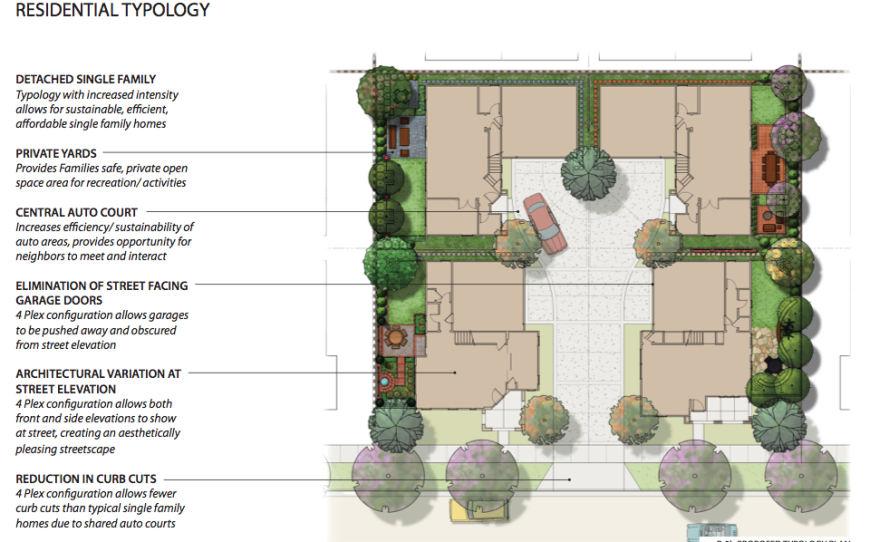The master-planned community of Otay Ranch in Chula Vista was just halfway done, having built about ten thousand new homes, when the housing crisis stopped it in its tracks. Today, sales are beginning to crawl back upwards. And Spanada Ingram is one of the people who has just moved in.
But the homes being built now in Otay Ranch are different than the ones they built ten years ago, when the home market was booming. Earlier this year, the Chula Vista City Council amended the permits to allow developers to build smaller homes on smaller lots.
Stephen Haase is in charge of planning for Baldwin & Sons, the developer of many homes in a part of the development called Village 2. He said the changes were made to respond to a changing market that demands lower prices.
“These are single-family homes, on individual lots, with their own backyard,” he said of the homes. “The American dream is still very alive. It just has been shrunken a little bit.”
Haase said the size of the homes he’s selling has dropped to around 2,000 square feet, compared to 3,000 square feet, which was typical of the past decade. The market has forced developers to offer lower prices but still provide an attractive product. Haase said they’ve tried to do that by using some innovative designs. One example is clustering homes in sixes and fours.
One of the most characteristic things about these home clusters is they only have one driveway. A shared driveway means the lots can be smaller, for one thing. They also have less street frontage, and that means lower costs.
“We reduce the amount of street that we have to build for each house,” said Kent Aden, an executive with Otay Ranch New Homes, another developer building home clusters. “We save on construction costs which means we can offer a lower-priced home.”
But it’s not just affordability. The shared driveway gives a home cluster a kind of common courtyard. Remember the cul-de-sac? Suburban developers have largely abandoned them because they were very impractical for moving traffic. But cul-de-sacs created protected streets for kids to play on, and offered a central square where neighbors would gather.
Aden said the shared driveway is the new cul-de-sac.
“By doing this you’re creating that cul-de-sac environment without having a cul-de-sac, and it gives a lot of hard surface for kids to play on,” he said.
Spanada Ingram can vouch for that.
“My youngest son would come out with his basketball. He’d be right here, and I don’t have to worry about people speeding up through my driveway,” said Ingram.
Ingram’s neighbor, Bruce Bjornson, said he often works in his garage, which faces the common courtyard.
“I have my garage door open like I might be doing something,” he said. “The guys behind me, they might come out and walk by and we’ll stop and talk for a while.”
Urban planners say not giving every home a driveway means home fronts become a more dominant feature on the street. They’re also featuring home fronts in Village 2 in very old-fashioned way: By creating alleys to keep cars and garages in back.
But price remains the dominant factor in any buyer’s decision. Ingram and Bjornson bought their homes for between $380,000 and $420,000. Mark Goldman is a business lecturer at San Diego State and a mortgage broker. He said those prices are just a bit above the median home price for San Diego County, and that’s a good deal because people will pay more for new homes. I asked him why.
“Why do people buy new cars?” he responded. “Some people just want that new original bathtub, that new original room. People will pay a premium for it. And there are the new features and new design innovations and energy conservation.”
In its heyday, Otay Ranch was selling one thousand homes every year. Even now that sales have picked up, they’re only moving about 100 homes a year.
At some point, housing demand will cause home sales to rebound to something more akin to pre-recession levels. But Stephen Haase said the housing bust has brought a fundamental change in home design. The days of the “McMansion” are behind us. He tells of a San Diego man who moved to Temecula to buy a bigger house.
“I asked him how he liked it up there. He said he hated the commute. He had a house so large there were some weeks when he didn’t even go into some of the rooms in his house,” said Haase, who rhetorically wondered why people would buy homes they don’t even use.
“Well, we had a tendency to do that as a society. But now we’re becoming more realistic about what our needs are,” he added.
The Otay Ranch master plan calls for a total of 26,000 new homes. There’s no telling how long building and selling that many houses will take, or whether it will ever actually happen. But for now, Spanada Ingram is just happy to be home.
“Welcome to my neighborhood!” he said with a laugh.








